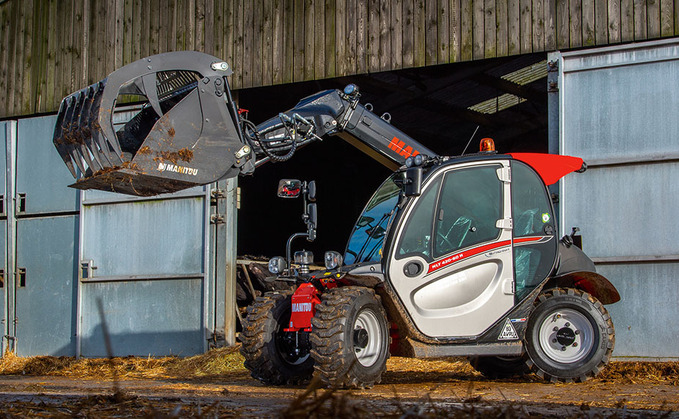
Representing the smallest ag-spec telehandler the firm has ever produced, we try out the latest compact machine from Manitou. James Rickard finds out more with a test drive.
At just under 1.5m wide and just under 2m tall, the latest compact machine from Manitou is said to be suited to a variety of situations where space is at a premium. Whether it is in poultry sheds, traditional farm buildings or as a support machine to a larger loader, the new MLT420-60H telehandler could provide a useful answer.
However, as is often the case with ‘compact' machines, squeezing all those components into a small package frequently comes at a cost, with areas such as comfort and performance often suffering. But with a lift capacity of two tonnes, a lift height of more than four metres and the same cab as used on a larger model, is this the case with the new mini Manitou? And is it worth taking one of these over a small pivot steer loader or a skid steer?
Handling
handling 1
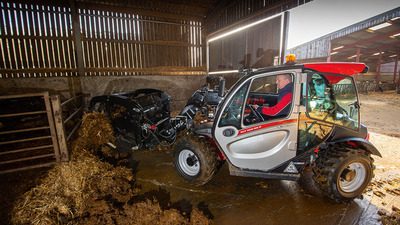
As you would expect, the 420 is very agile. It also has a lot of in-built weight, which means it is well planted, keeping it stable and giving it plenty of pushing power.
Capable of lifting two tonnes to just over four metres (to the bottom of the pallet forks), it proved a useful machine for a variety of tasks during our test, particularly mucking out. And for those who have stuck with a loader tractor, but are now finding that it is starting to outgrow buildings, the little 420 could prove a good alternative, while still offering the same lifting capacity.
The only thing holding it back slightly is its 77 litre/minute hydraulic pump, which cannot cope with multiple loader movements. For this you will need a fair bit of revs piling on, but for a loader of this size it is adequate.
handling 2
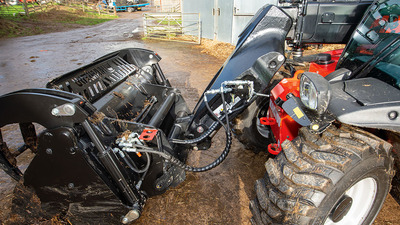
Up front, the headstock is Manitou's own, and is the same as used on its machines up to a six tonne lift capacity - ideal if the MLT420 is a support machine to a larger Manitou. Unfortunately, Manitou will not fit other types of headstock at the factory, but dealers should be able to fit a headstock of your choice.
Headstock locking is hydraulic, with oil simply diverted from the third service via tap. Usefully, there is also a third service ‘dump' button on the outside of the cab, releasing all hydraulic pressure and helping to couple/uncouple pipes.
Extra LED lights can also be specced on the boom, as can a fourth service, an electric power supply, a free-flow return and the ability to adjust third service flow rate. Couple this with an optional hand throttle and it means you can set your flow and independently control your forward speed.
Unfortunately, there is no boom suspension option, which can prove a bit of a bone rattler around the yard, particularly with industrial tyres fitted. It is more than tolerable, though.
Capability
cap 1
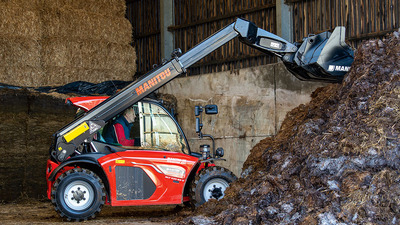
Complying with handling legislation, the 420 gets three working modes; general handling, bucket and suspended load.
General handling is the default mode on start-up. In this mode, if the load limit is reached and the hydraulics lock-out, it will only allow you to lift or retract the boom - essentially bringing the load closer to the machine.
Bucket mode builds on this and will allow you to also tilt and crowd the headstock and be able to use the third service. However, if you do not use the joystick for more than 30 seconds, or you leave the seat, the system will de-fault back to general handling mode. This is unfortunate, as bucket mode is probably the most used around the farm.
cap 2
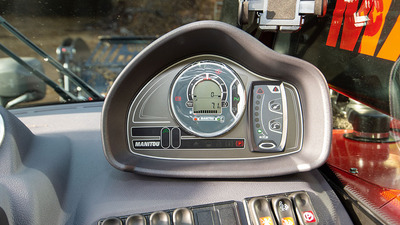
In suspended load mode, the lifting capacity is de-rated by 5 per cent, to take into account spike loads when an object swings, and will lock out the tilt and crowd when the boom is extended. However, this mode will stay active even after leaving the seat, but will default back to handling mode if the machine is keyed off.
While mode selection is easy enough, it is a shame it cannot remember and save the last mode used. According to Manitou, this is to ensure the machine is in the safest mode when restarted by the next operator.
However, if you want to make the most of the machine, the overload ‘cut-off' devices are disabled while the boom is fully retracted. So if you want to really get stuck into some bedding muck, leave the boom in.
Engine
eng 1
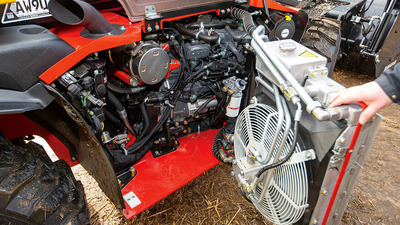
Providing power to the MLT420 is an equally compact 2.6-litre, four-cylinder Kubota engine. It is a revvy little motor and works with the transmission well to quickly pick its feet up when darting around the yard. It is a smooth uptake of speed too, with good engine/transmission braking - you hardly need to use the foot brake. The latter also incorporates an inching functions, allowing you to ‘bleed' off a bit of transmission oil, giving finer control over speed. In addition, the shuttle is naturally aggressive, but smooth with it - won't break your neck.
As for engine access, Manitou has clearly thought about this, with several fold up/out elements which allow you to get right into the belly of the engine bay. For daily checks, a simple top cover opens; greater access is then afforded to the radiators by simply removing a side panel; and if annual maintenance or repair is required, the whole cooling package just unclips and folds out of the way to reveal the engine and transmission. It is a fine piece of engineering.
Transmission
trans 1
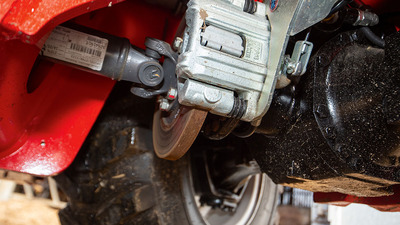
Driving power to the wheels is a hydrostatic transmission. By the press of a button on the joystick, this can be used in one of two modes; low range offering speeds of 0-6kph, or high range from 0-25kph. There is no mechanical range change, just an electronic limiting of the hydro in low range. And in low range, throttle pedal movement is effectively de-sensitised making it very accurate to control. However, it will be very rare that low range will be used as high range is ideal for most tasks around a yard.
A single, external disc brake on the prop-shaft takes care of stopping power. It does the job well, but it is something to be aware of as it is one of the machines' lowest parts. Acting on the brake is both the foot brake and the park brake. The latter is fully automated and is really handy - every time the machine is put in neutral or you come to a stop, it will engage. This means while working you can pull up to a muck spreader, for example, flick it in neutral and it will hold itself while you get on with making the boom move. It also works really well on hills, and comes on and off predictably without interference.
Cab and controls
cab 1
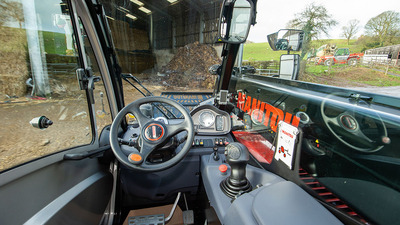
The MLT420 shares the same cab as the larger 625 model. This means you get loads of cab space and comfort for a machine of this size. Even taller drivers will appreciate the amount of head and leg room available.
Access is spot on too; no steps, wide opening door and nothing to catch your clothes on. Like many, the door splits, with the ability to lock top half back. The inside door handle is also within easy reach, with no stretching to get hold of it.
The firm has not shirked on comfort either, with reach and rake adjustable steering and plenty of seat adjustment.
Two spec levels of the MLT420 are available; Classic and Premium (as tested), with the latter gaining air conditioning, LED lights, air seat and Bluetooth connectivity.
cab 2
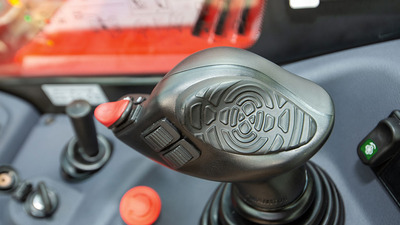
Love it or hate it, the MLT420 gets Manitou's famous JSM joystick, putting all primary controls to hand. This includes direction control which is right hand control only on this machine, so may not suit those who love a left hand stick.
Visibility is good overall. Being such a small machine it is relatively easy to see at least three of the corners, and easy to judge where the right/rear of the machine is.
Views to the right are dominated by the boom which does not have a channel to sit in and effectively sits on top of the engine bay. As such there is not that much of the machine that sticks out to the right, making it easier to gauge how close you are to a wall.
Practicalities
bucket grab
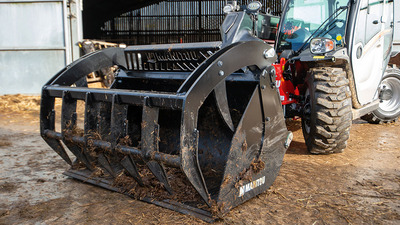
The test also provided us a chance to try the firm's latest bucket grab with removable sides and side teeth.
rear
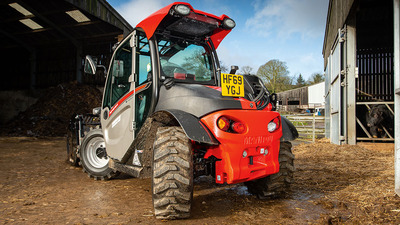
Fixed, flexible mudguards cover the rear tyres, which in our case were the harder wearing industrial option, suiting the yard.
Greasing points
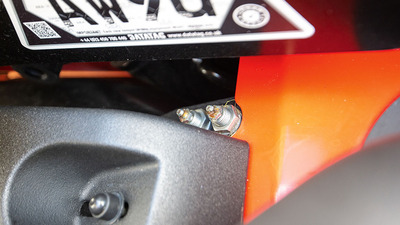
Helping maintenance are remote greasing points, which supply main boom pivots and the rear axle.
Storage
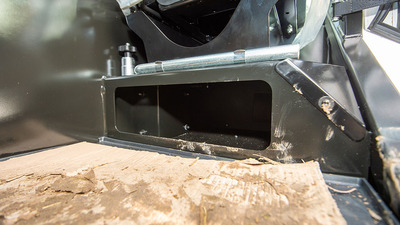
There is a little bit of in-cab storage; under the right hand armrest and a good space under the seat.
MLT420-60H specifications
- Engine: 2.6-litre, four-cylinder, Stage 5, Kubota
- Power: 57hp
- Transmission: Two range hydrostatic (0-6 and 0-25kph)
- Hydraulics: Gear pump offering 77 litres/minute
- Maximum lift capacity: 2,000kg
- Fully extended forward lift capacity: 900kg
- Maximum lift height: 4,300mm to bottom of pallet tines
- Un-laden weight (with pallet tines): 4,190kg
- Overall width (to outside of tyres): 1,490mm
- Overall height: 1,970mm
- Steering modes: Manually selectable four wheel, front and crab
- External turning radius (to outside of tyres): 3,060mm
- Retail price: From £55,000 (£57,750 as tested)
Verdict
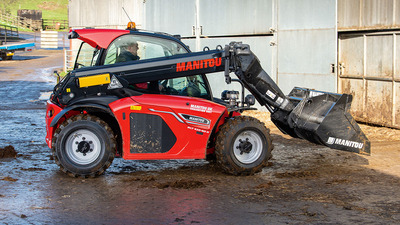
Never have we driven a machine so small, have we felt so comfortable - even better than some larger telehandlers and loaders we have tried.
The thought that has gone into the packaging of this machine is a work of genius, which means few compromises have had to be made.
It certainly does what it is intended to do, and ticks a lot of boxes when it comes to working in confined spaces.
Granted, lack of boom suspension can make it an uncomfortable ride, and the handling modes are a bit of a faff, but overall it is a machine that punches well above its size.































